
Stevens Institute of Technology
Encyclopedia
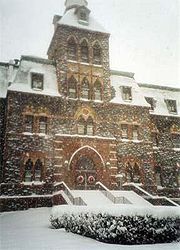
Hoboken, New Jersey
Hoboken is a city in Hudson County, New Jersey, United States. As of the 2010 United States Census, the city's population was 50,005. The city is part of the New York metropolitan area and contains Hoboken Terminal, a major transportation hub for the region...
, USA – founded in 1870 with an 1868 bequest from Edwin A. Stevens
Edwin A. Stevens
Edwin Augustus Stevens was an American engineer, inventor, and entrepreneur who left a bequest that was used to establish the Stevens Institute of Technology.-Early life and family:...
. It is known for its engineering
Engineering
Engineering is the discipline, art, skill and profession of acquiring and applying scientific, mathematical, economic, social, and practical knowledge, in order to design and build structures, machines, devices, systems, materials and processes that safely realize improvements to the lives of...
, science
Science
Science is a systematic enterprise that builds and organizes knowledge in the form of testable explanations and predictions about the universe...
, and technological management
Management
Management in all business and organizational activities is the act of getting people together to accomplish desired goals and objectives using available resources efficiently and effectively...
curricula.
The institute has produced leading engineers, scientists, and managers in industry and government. Two members of the Stevens community, as alumni or faculty, have been awarded the Nobel Prize: Frederick Reines
Frederick Reines
Frederick Reines was an American physicist. He was awarded the 1995 Nobel Prize in Physics for his co-detection of the neutrino with Clyde Cowan in the neutrino experiment, and may be the only scientist in history "so intimately associated with the discovery of an elementary particle and the...
(class of 1939), in Physics, and Irving Langmuir
Irving Langmuir
Irving Langmuir was an American chemist and physicist. His most noted publication was the famous 1919 article "The Arrangement of Electrons in Atoms and Molecules" in which, building on Gilbert N. Lewis's cubical atom theory and Walther Kossel's chemical bonding theory, he outlined his...
(Chemistry faculty 1906-1909), in chemistry.
The Stevens campus encompasses Castle Point, the highest point in Hoboken. Historic Sybil's Cave bores into the side of Castle Point, and below and to the east of the university is Frank Sinatra Park, Castle Point Park, and Castle Point Skate Park. The tallest building in the institute is the Wesley J. Howe Center, occupying the site of the former "Stevens Castle" on Castle Point.
Among the prominent research centers of Stevens are the Davidson Laboratory, Wireless Network Security Center, Keck Geotechnical Laboratory, Plasma Physics Laboratory, Nicoll Environmental Laboratory, Electron Microscopy Laboratory, Center for Mass Spectrometry and the Center for Complex Adaptive Sociotechnological Systems (COMPASS).
Dr. Nariman Farvardin is the seventh president of Stevens. He took office July 1, 2011.
Education environment
Stevens is composed of four academic schools: the Charles V. Schaefer, Jr. School of Engineering and Science, the College of Arts and Letters, the Wesley J. Howe School of Technology Management and the School of Systems and Enterprises.Stevens offers the Bachelor of Engineering
Bachelor of Engineering
The Bachelor of Engineering is an undergraduate academic degree awarded to a student after three to five years of studying engineering at universities in Armenia, Australia, Bangladesh, Bulgaria, Canada, China, Denmark, Egypt, Finland , Germany, Hong Kong, India, Indonesia, Ireland, Jordan, Korea,...
(B.E.) degree in electrical, chemical, biomedical, materials, civil, mechanical, systems, computer, environmental, naval, and ocean engineering, as well as in engineering management. A total of 145-155 credits is required for the B.E. degree. The engineering programs are accredited by the Accreditation Board for Engineering and Technology (ABET) and have been accredited by ABET continuously since 1936.
The Bachelor of Science
Bachelor of Science
A Bachelor of Science is an undergraduate academic degree awarded for completed courses that generally last three to five years .-Australia:In Australia, the BSc is a 3 year degree, offered from 1st year on...
(B.S.) degree is offered in chemistry, business & technology management, computer science, mathematics, physics, materials science, and chemical biology/biochemistry. At the graduate level, Stevens offers the Master of Engineering (M.Eng.), Master of Technology Management (M.T.M.), Master of Science (M.S.), Master of Business Administration (M.B.A.), Engineer (E.E., M.E., Comp. E., C.E., and Ch. E.), and Doctor of Philosophy (Ph.D.) degrees.
Stevens offers an accelerated Chemical Biology/Pre-Medical program with the University of Medicine and Dentistry of New Jersey
University of Medicine and Dentistry of New Jersey
The University of Medicine and Dentistry of New Jersey is the state-run health sciences institution of New Jersey, United States. It has eight distinct academic units...
. In this program, students can enter the medical school after the third year at Stevens. Stevens confers the B.S. degree after the first year of medical school.
There is also a prelaw program with New York Law School
New York Law School
New York Law School is a private law school in the TriBeCa neighborhood of Lower Manhattan in New York City. New York Law School is one of the oldest independent law schools in the United States. The school is located within four blocks of all major courts in Manhattan. In 2011, New York Law School...
, and a "3-2" (5 year) dual-degree program with New York University
New York University
New York University is a private, nonsectarian research university based in New York City. NYU's main campus is situated in the Greenwich Village section of Manhattan...
, in which students earn a B.S. in science from NYU, in addition to the B.Eng. from Stevens. Stevens Institute of Technology International
Stevens Institute of Technology International
"Stevens Institute of Technology International " Spanish: "Stevens Instituto Especializado de Estudios Superiores” is a new private university in the Dominican Republic that offers technology and technology management education, taught in English....
offers two graduate programs in the Dominican Republic – a Master of Science in Information Systems and a Master of Engineering Manufacturing Technology and Project Management
The mission of the Charles V. Schaefer, Jr. School of Engineering & Science is to address the challenges facing engineering and science now and into the future while remaining true to the vision of the founders of Stevens as one of the first dedicated engineering schools in the nation. The Schaefer School of Engineering & Science offers Bachelor's, Master's and Doctoral degrees in various engineering and scientific disciplines for the traditional full time students as well as part time professionals.
The School of Systems and Enterprises (SSE) emphasizes the industry and government experience of its faculty to provide real-world applications to its students. SSE offers a range of programs including Bachelor’s, Master’s, and Doctoral degrees along with a combined Bachelor’s and Master’s program and Graduate Certificates. Graduate courses at SSE are provided through flexible program delivery with options including on campus, at a work site or online through Stevens’ WebCampus.
In 2010, Stevens opened a new location at the Ronald Reagan Building
Ronald Reagan Building
The Ronald Reagan Building and International Trade Center, named after former United States President Ronald Reagan, is the first federal building in Washington, D.C. designed for both governmental and private sector purposes....
in Washington, D.C. offering graduate courses focused on technology management, systems engineering, and the sciences.
The College of Arts and Letters (CAL) approaches the humanities, social sciences, and the arts from a science and technology perspective. While every undergraduate at Stevens is required to take a set of humanities courses, CAL offers Bachelor of Arts degrees in literature, history, philosophy, and the social sciences. CAL was established as a separate college in 2007 as part of a larger institutional realignment. CAL's formation followed a history of integrating humanities and liberal arts education which dates back to the university's founding in 1870. In Fall 2011 CAL will be offering a new M.A. and graduate certificate in Technology, Policy, and Ethics.
The Wesley J. Howe School of Technology Management emphasizes quantitative methods of management, particularly those unique to the management of technologically-based organizations. The Stevens undergraduate program emphasizes mathematical business models, applications of hard science to the concept and marketing of products, financial engineering (stochastic calculus, probability, and statistics as descriptors of the dynamic behavior of financial markets) and the case study method of business analysis. The capstone project in the Business curriculum is the design of a technology-based business, with the accompanying business plan, operations research, market analysis, financial prospectus, and risk analysis. Several of the capstone projects done in the business school have actually been realized in the marketplace as new companies.
Stevens has a 7:1 student to faculty ratio that allows smaller classes and increased opportunity for student-faculty interaction.
Current focus in Stevens is integration of business and technology, with technology coming first. The aim is to produce alumni possessing both the skills to create and to lead and manage technological projects.
The Honor System gives the student the privilege to take an examination without proctoring by a professor. Students are required to sign the Honor System pledge attesting that they have not "asked for, given, nor received aid during this examination" in exchange for that privilege. The pledge reads, "I pledge my honor that I have abided by the Stevens Honor System." At the time of its incorporation, students taking examinations were watched closely by a proctor, and asking not to be proctored was a revolutionary idea. Proctoring presumes students will not do the honorable thing, whereas the Honor System places great trust in the students. Stevens treats its students as future professionals, who will maintain the honor and integrity of their professions. In the case of infractions of the Honor System, a jury of the student's peers hears the case in a trial and decides the outcome.
Stevens was the first technological university in the United States with a humanities department. At least eighteen credit hours of humanities (history, literature, social science, philosophy, and art/music) are required of all undergraduates.
Athletics
The sports teams are called the Ducks. They participate in the Empire 8Empire 8
The Empire 8 is an intercollegiate athletic conference affiliated with the NCAA’s Division III.-Members:Full member institutions include:-Football affiliation:*Springfield College...
Conference and NCAA Division III. They were one of the first 5 College football teams
History
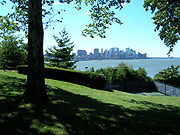
In 1784, the land now occupied by Stevens Institute of Technology was purchased by John Stevens
John Stevens (inventor)
Col. John Stevens, III was an American lawyer, engineer and an inventor.-Life and career:Born the son of John Stevens , a prominent New Jersey politician who served as a delegate to the Continental Congress, and Elizabeth Alexander, daughter of New York lawyer and statesman James Alexander. His...
, who would later reverse engineer the British steam locomotive to American standards for domestic manufacture. Robert Stevens, one of John Stevens' sons is known for inventing the flanged T rail, a form of railroad rail in use today throughout the world. With his brother Edwin A. Stevens
Edwin A. Stevens
Edwin Augustus Stevens was an American engineer, inventor, and entrepreneur who left a bequest that was used to establish the Stevens Institute of Technology.-Early life and family:...
, Robert created America's first commercial railroad.
When Edwin A. Stevens died in 1868, he left a bequest in his will as an endowment for the establishment of an "institution of learning", providing his trustees with land and funds.
The Stevens Institute of Technology opened in 1870 and initially was dedicated to mechanical engineering.
The original course of study was a single, rigorous curriculum that was based upon the European model of science, modeled after the French and German scientific and technical schools, rather than the shop schools that were common at that time. The original degree offered was that of "Mechanical Engineer" (M.E.), in addition to a Ph.D. in mechanical engineering, chemistry, or physics. Stevens granted several Ph.D.s between 1870 and 1900, making it one of the earliest Ph.D. granting institutions in the United States. The broad-based interdisciplinary philosophy was put into practice by the founders from the first graduating class. While the original area of concentration was mechanical engineering, and despite the title of the degree, the curriculum included courses in all of the then-current engineering disciplines; mechanical, civil, chemical, and electrical engineering. In 1880, Robert H. Thurston, professor of mechanical engineering at Stevens, was nominated the first president of the American Society Of Mechanical Engineers.
During World War II
World War II
World War II, or the Second World War , was a global conflict lasting from 1939 to 1945, involving most of the world's nations—including all of the great powers—eventually forming two opposing military alliances: the Allies and the Axis...
, Stevens Institute of Applied Science was one of 131 colleges and universities nationally that took part in the V-12 Navy College Training Program
V-12 Navy College Training Program
The V-12 Navy College Training Program was designed to supplement the force of commissioned officers in the United States Navy during World War II...
which offered students a path to a Navy commission.
In 1959 the undergraduate engineering degree was changed to the Bachelor of Engineering (B.Eng.) to reflect the broad-based interdisciplinary engineering curriculum (note that the M.E. degree of that time was a baccalaureate
Bachelor's degree
A bachelor's degree is usually an academic degree awarded for an undergraduate course or major that generally lasts for three or four years, but can range anywhere from two to six years depending on the region of the world...
degree, not to be confused with the present Engineer's degree
Engineer's degree
An engineer's degree is an advanced academic degree in engineering that is conferred in Europe, some countries of Latin America, and a few institutions in the United States....
which is a terminal professional graduate degree).
The campus began on the edge of the family estate at Castle Point in Hoboken. It occupied a single building now designated the Edwin A. Stevens Building and a Federal historical landmark. Stone designs on the building's facade are believed to be derived from a pattern repeated in the floor mosaic of Hagia Sophia
Hagia Sophia
Hagia Sophia is a former Orthodox patriarchal basilica, later a mosque, and now a museum in Istanbul, Turkey...
, the great cathedral in Istanbul, which Edwin A. Stevens is believed to have visited in the late 19th century.
In 1959, the 40-room Victorian
Victorian architecture
The term Victorian architecture refers collectively to several architectural styles employed predominantly during the middle and late 19th century. The period that it indicates may slightly overlap the actual reign, 20 June 1837 – 22 January 1901, of Queen Victoria. This represents the British and...
mansion, "Castle Stevens" was demolished to be replaced in 1962 by the 14-story Administration Building, later renamed the Wesley J. Howe building.
In 1906, students at Stevens, under the guidance of President Humphrey, created the Honor System
Honor system
An honor system or honesty system is a philosophical way of running a variety of endeavors based on trust, honor, and honesty. Something that operates under the rule of the "honor system" is usually something that does not have strictly enforced rules governing its principles...
– moral and ethical code governing the life of Stevens students, preaching equality and honest work.
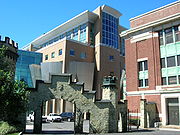
Frederick Winslow Taylor
Frederick Winslow Taylor was an American mechanical engineer who sought to improve industrial efficiency. He is regarded as the father of scientific management and was one of the first management consultants...
(M.E., 1883), the "father of scientific management," developed time and motion studies in the steel industry and other manufacturing industries. The time and motion studies elucidated the most efficient way to do each task, the methods of distributing work in a factory, the assigning of production resources to workers and processes, and the quantifying and measuring of the resulting productivity. His books Shop Management and The Principles of Scientific Management remain classic monographs in the field. Although few or no plants today employ exactly the system of management that Taylor described, the underlying principles of analysis and empiricism that shaped his methods are still in use today. Henry Gantt
Henry Gantt
Henry Laurence Gantt, A.B., M.E. was an American mechanical engineer and management consultant who is most famous for developing the Gantt chart in the 1910s....
, Taylor's classmate, was the developer of the "Gantt chart
Gantt chart
A Gantt chart is a type of bar chart that illustrates a project schedule. Gantt charts illustrate the start and finish dates of the terminal elements and summary elements of a project. Terminal elements and summary elements comprise the work breakdown structure of the project. Some Gantt charts...
", which is a graphical technique for identifying the critical path- the succession of particular steps in a process that control the cost and schedule as a function of the dependencies between the steps. Present day, computer-aided program evaluation and review techniques, critical path optimization, and linear programming techniques still utilize Gantt's principles.
Closely associated with time-motion studies was the psychology of employee and organizational behavior. Dr. Charles Gaudet organized one of the first Psychological Studies Laboratories at Stevens in 1945. The Laboratory developed psychological tests and standards for public employees such as police and fire. These tests, elements of which are in use today, have proven themselves accurate predictors of performance under stressful conditions.
During the Manhattan Project
Manhattan Project
The Manhattan Project was a research and development program, led by the United States with participation from the United Kingdom and Canada, that produced the first atomic bomb during World War II. From 1942 to 1946, the project was under the direction of Major General Leslie Groves of the US Army...
, the International Nickel Company, under the direction of president Charles Stanley (M.E., 1943) developed the ultra-pure nickel that was used to fabricate diffusion barriers used in the gaseous isotope diffusion separation process at Los Alamos which produced the uranium-235 used in the Hiroshima atomic bomb
Atomic bombings of Hiroshima and Nagasaki
During the final stages of World War II in 1945, the United States conducted two atomic bombings against the cities of Hiroshima and Nagasaki in Japan, the first on August 6, 1945, and the second on August 9, 1945. These two events are the only use of nuclear weapons in war to date.For six months...
. Previous attempts at gas diffusion failed due to impurities in the diffusion barrier alloys causing corrosion of the apparatus by the uranium hexafluoride gas used in the process. Frederick Reines
Frederick Reines
Frederick Reines was an American physicist. He was awarded the 1995 Nobel Prize in Physics for his co-detection of the neutrino with Clyde Cowan in the neutrino experiment, and may be the only scientist in history "so intimately associated with the discovery of an elementary particle and the...
, (M.E., 1939, M.S., 1941), who would later discover the neutrino — which won him the Nobel Prize
Nobel Prize
The Nobel Prizes are annual international awards bestowed by Scandinavian committees in recognition of cultural and scientific advances. The will of the Swedish chemist Alfred Nobel, the inventor of dynamite, established the prizes in 1895...
in 1995 — directed the experimental division of the Manhattan Project.
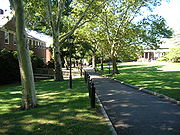
SS Stevens
SS Stevens, a , 14,893-ton ship, served as a floating dormitory from 1968 to 1975 for about 150 students of Stevens Institute of Technology, a technological university, in Hoboken, NJ...
, a 473-foot, 14,893-ton ship, served as the floating dormitory from 1968 to 1975 for about 150 students. Permanently moored on the scenic Hudson River
Hudson River
The Hudson is a river that flows from north to south through eastern New York. The highest official source is at Lake Tear of the Clouds, on the slopes of Mount Marcy in the Adirondack Mountains. The river itself officially begins in Henderson Lake in Newcomb, New York...
at the foot of the campus across from New York City
New York City
New York is the most populous city in the United States and the center of the New York Metropolitan Area, one of the most populous metropolitan areas in the world. New York exerts a significant impact upon global commerce, finance, media, art, fashion, research, technology, education, and...
, this first collegiate floating dormitory became one of the best known college landmarks in the country. Following the sale of the ship, students of the Class of 1975 presented funds to the institute for the preparation of a site on Wittpenn Walk where one of Stevens
During World War II, the institute was honored by the naming of the Victory Ship
Victory ship
The Victory ship was a type of cargo ship produced in large numbers by North American shipyards during World War II to replace shipping losses caused by German submarines...
, SS Stevens Victory, a merchant cargo ship built by the Bethlehem Fairfield Shipyard at Baltimore. Launched on May 29, 1945, the ship was among of a group of 150 ships that were named for US Colleges and Universities.
Starting in 1971, women were first allowed to enroll in Stevens.
In 1982, Stevens was the first institution in the U.S. to require all incoming freshman undergraduate students to purchase and use a personal computer. Around this time, an intranet was installed throughout the campus, which also placed Stevens among one of the very first universities with campus networks.
WCPR, the radio station of Stevens Institute of Technology, has one of the largest record collections in the state of New Jersey at over 10,000 LPs.
Research at Stevens
The Research Enterprise at Stevens features three National Research Centers of Excellence: the Center for Secure & Resilient (CSR) Maritime Commerce; Systems Engineering Research Center (SERC); and the Atlantic Center for the Innovative Design & Control of Small Ships (ACCESS). Stevens also features the Center for the Advancement of Secure Systems & Information Assurance (CASSIA), a nexus for research advancements in cybersecurity in addition to a wide range of research centers and facilities.Research at Stevens is structured into three overarching areas that are based on the needs of society and a determination of how the assets of the university can be utilized by industry and entrepreneurs.
- Nanotechnology & Multi-scale Systems - Develops and implements nanotechnology-enabled solutions spanning a broad spectrum of engineering and science disciplines. Rooted in nanoscale science, yet, focused on real-world problems, these emerging technologies will have transformative value in the areas of national and global interest including energy, health, electronics, communications, the environment and national security.
- Secure Systems - Is a cross-disciplinary research area focused on developing transitional breakthroughs in national security technology. The Maritime Security Laboratory established in partnership with the U.S. Navy focuses on emerging maritime threats while researchers in the departments of Mathematics, Computer Science, Computer Engineering and Physics work on a wide variety of cybersecurity issues.
- Systems Engineering & Enterprise Management - Addresses questions that are related to the nature of sociotechnologic systems within the context of global competitiveness in their process to create economic value. Research efforts create unique knowledge about the functionality of socioeconomic systems and focus on developing practical methods, tools and heuristics that leaders can apply to increase the productivity of sociotechnical systems and improve their economic value.
Dr. Joseph Mitola III is the Vice President of the Research Enterprise.
NJ Attorney General Matter
In 2009, after a two-year investigation by the New Jersey Attorney General, Stevens and the attorney general filed competing lawsuits against one another. The New Jersey Attorney General suit against Stevens, its then-president and chairman of the Board of Trustees alleged numerous claims involving breach of fiduciary duty and other causes of action primarily relating to financial practices and the financial management of the Institute and the compensation and certain loan transactions involving the then-president. The Stevens suit against the attorney general contended that the state attorney general had overstepped her legal authority over a private institution, and sought that any case be pursued by confidential arbitration.On January 15, 2010, Stevens announced that the institute and the New Jersey Attorney General's office agreed to a settlement of the September, 2009 lawsuit filed by the NJ Attorney General, as well as the separate suit filed by Stevens against the Attorney General. In the settlement, the parties agreed to a number of changes to Stevens' governance procedures, and it appointed a Special Counsel to oversee the implementation of these changes and prepare periodic reports on Stevens’ progress. Additionally, in a letter to the institute on January 15, 2010, the chairman of the Board of Trustees, Lawrence T. Babbio Jr., and the then-president Harold J. Raveché announced that Raveché had voluntarily decided that he would not continue as president beyond June 30, 2010 after 22 years of service as the institute's sixth president. The settlement made Dr. Raveché a consultant to the Institute through October 2011 and forced him to repay the outstanding balance of loans previously made to him by Stevens. It concludes with no admission of liability or unlawful conduct by any party.
The Special Counsel, as appointed in the settlement, prepared six reports on the progress on the governance changes outlined in the settlement agreement. The sixth and final quarterly report, dated August 3, 2011, states that Stevens completed on schedule the agreed upon changes to its governance procedures and that “Special Counsel now finds Stevens to be in full compliance with the terms of the Consent Judgment.” While the specific compliance requirements have been fulfilled, the Special Counsel will continue to monitor certain activities of Stevens through February of 2012.
Notable alumni
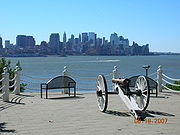
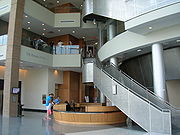
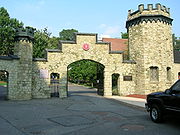
- Lawrence Babbio, B.E., 1966, vice chairman and president of Verizon Communications, Domestic Telecom Group.
- Igor BensenIgor BensenIgor Bensen was the founder of the Bensen Aircraft, which produced a successful line of Gyrogliders and Autogyros...
, B.E. Mechanical Engineering, 1940, founder of Bensen AircraftBensen AircraftThe Bensen Aircraft Corporation was established by Dr. Igor Bensen at Raleigh-Durham International Airport in North Carolina in 1952 to develop and market a variety of helicopters and autogyros of Bensen's own design....
. - George M. Bond, creator of the eyepiece micrometer
- Samuel P. BushSamuel P. BushSamuel Prescott Bush was an American industrialist and entrepreneur, and the patriarch of the Bush political family. He was the father of U.S. Senator Prescott Bush, grandfather of former U.S President George H. W. Bush, and great-grandfather of former U.S. President George W...
, 1884, steel and railroad executive, public servant, patriarch of Bush political familyBush familyThe Bush family is a prominent American family. Along with many members who have been successful bankers and businessmen, across three generations the family includes two U.S. Senators, one Supreme Court Justice, two Governors, one Vice President and two Presidents... - Alexander CalderAlexander CalderAlexander Calder was an American sculptor and artist most famous for inventing mobile sculptures. In addition to mobile and stable sculpture, Alexander Calder also created paintings, lithographs, toys, tapestry, jewelry and household objects.-Childhood:Alexander "Sandy" Calder was born in Lawnton,...
, M.E., 1919, creator of the MobileMobile (sculpture)A mobile is a type of kinetic sculpture constructed to take advantage of the principle of equilibrium. It consists of a number of rods, from which weighted objects or further rods hang. The objects hanging from the rods balance each other, so that the rods remain more or less horizontal...
and popularizer of that art form - Alfred KinseyAlfred KinseyAlfred Charles Kinsey was an American biologist and professor of entomology and zoology, who in 1947 founded the Institute for Sex Research at Indiana University, now known as the Kinsey Institute for Research in Sex, Gender, and Reproduction, as well as producing the Kinsey Reports and the Kinsey...
- Fred H. ColvinFred H. ColvinFred Herbert Colvin was an American machinist, technical journalist, author, and editor. He wrote, co-wrote, edited, or co-edited many periodical articles, handbooks, and textbooks related to engineering, machining, and manufacturing...
, M.E. Hon., 1944, journalist, author, and editor in the fields of manufacturing, machine tools, etc. - James Corcoran, M.E., M.S., President and CEO, Lockheed Martin Corporation
- Hiten Patel, M.S., Chairman and CEO, Collabera IncCollaberaCollabera is a CMMI Level-5 end-to-end information technology services and solutions provider working with organizations from the Financial Services, Technology, Communications & Media, Manufacturing & Retail, Energy and Utilities domains.-History:...
- Leon Febres CorderoLeón Febres CorderoLeón Esteban Febres-Cordero Ribadeneyra was President of Ecuador for a four-year term from 10 August 1984 to 10 August 1988...
, M.E., 1953, President of EcuadorEcuadorEcuador , officially the Republic of Ecuador is a representative democratic republic in South America, bordered by Colombia on the north, Peru on the east and south, and by the Pacific Ocean to the west. It is one of only two countries in South America, along with Chile, that do not have a border...
, 1984–1988 - Mark CrispinMark CrispinMark Crispin is best known as the father of the IMAP protocol, having invented it in 1985 during his time at the Stanford Knowledge Systems Laboratory. He is the author or co-author of numerous RFCs; and is the principal author of UW IMAP, one of the reference implementations of the IMAP4rev1...
, B.S., 1977, Inventor of IMAP - Nate Davis, B.E., President and COO - XM Satellite RadioXM Satellite RadioXM Satellite Radio is one of two satellite radio services in the United States and Canada, operated by Sirius XM Radio. It provides pay-for-service radio, analogous to cable television. Its service includes 73 different music channels, 39 news, sports, talk and entertainment channels, 21 regional...
; formerly COO of XO CommunicationsXO CommunicationsXO Communications is a telecommunications company owned by XO Holdings, Inc... - L. Sprague de CampL. Sprague de CampLyon Sprague de Camp was an American author of science fiction and fantasy books, non-fiction and biography. In a writing career spanning 60 years, he wrote over 100 books, including novels and notable works of non-fiction, including biographies of other important fantasy authors...
, M.S., 1933, science fiction author, Lest Darkness FallLest Darkness FallLest Darkness Fall is an alternate history science fiction novel written in 1939 by author L. Sprague de Camp. The book is often considered one of the best examples of the alternate history genre; it is certainly one of the most influential...
, The Wheels of If, The Great Monkey TrialThe Great Monkey TrialThe Great Monkey Trial is a 1968 book on the Scopes Trial by L. Sprague de Camp, first published in hardcover by Doubleday. This history of the trial was based on the memoirs of John T...
, winner of the Hugo AwardHugo AwardThe Hugo Awards are given annually for the best science fiction or fantasy works and achievements of the previous year. The award is named after Hugo Gernsback, the founder of the pioneering science fiction magazine Amazing Stories, and was officially named the Science Fiction Achievement Awards...
(1997) - Alfred Fielding, 1939, Co-inventor of Bubble WrapBubble WrapBubble wrap is a pliable transparent plastic material commonly used for packing fragile items. Regularly spaced, protruding air-filled hemispheres provide cushioning for fragile items....
- Henry GanttHenry GanttHenry Laurence Gantt, A.B., M.E. was an American mechanical engineer and management consultant who is most famous for developing the Gantt chart in the 1910s....
, developed the Gantt chartGantt chartA Gantt chart is a type of bar chart that illustrates a project schedule. Gantt charts illustrate the start and finish dates of the terminal elements and summary elements of a project. Terminal elements and summary elements comprise the work breakdown structure of the project. Some Gantt charts...
, an important project management tool - Louis A. Hazeltine, M.E., Sc. D., 1926, founder Hazeltine CorporationHazeltine CorporationHazeltine Corporation was a defense electronics company which is now part of BAE Systems Inc.-History:The company was founded in 1924 by investors to exploit the Neutrodyne patent of Dr. Alan Hazeltine...
, inventor of the neutrodyne radio receiver - Richard HermanRichard HermanRichard H. Herman served as the Chancellor of the University of Illinois at Urbana-Champaign from 2005-2009. He previously served there as Provost and Vice Chancellor of Academic Affairs since 1998. While at the university he promoted excellence and diversity across the breadth of academic programs...
, B.S., 1963, Chancellor of the University of Illinois at Urbana-ChampaignUniversity of Illinois at Urbana-ChampaignThe University of Illinois at Urbana–Champaign is a large public research-intensive university in the state of Illinois, United States. It is the flagship campus of the University of Illinois system... - Peter Cooper HewittPeter Cooper HewittPeter Cooper Hewitt was an American electrical engineer and inventor, who invented the first mercury-vapor lamp in 1901. Hewitt was issued U.S. patent #682692 on September 17, 1901. In 1903, Hewitt created an improved version that possessed higher colour qualities which eventually found widespread...
, electrical engineer and inventor of the Mercury arc rectifier - Walter KiddeWalter KiddeWalter Kidde was born in Hoboken, New Jersey. He graduated from Stevens Institute of Technology in 1897. He was the owner of the Kidde company which manufactured fire extinguishers....
, B.E., 1897, founder of Walter Kidde Constructors; oversaw the construction of Port Newark and Kearny, New Jersey's first traffic circleTraffic circleA traffic circle or rotary is a type of circular intersection in which traffic must travel in one direction around a central island. In some countries, traffic entering the circle has the right-of-way and drivers in the circle must yield. In many other countries, traffic entering the circle must...
and the world's first cloverleaf interchangeCloverleaf interchangeA cloverleaf interchange is a two-level interchange in which left turns, reverse direction in left-driving regions, are handled by ramp roads...
, the Pulaski SkywayPulaski SkywayThe General Pulaski Skyway is a four-lane freeway composed of connected bridges in the northeastern part of the U.S. state of New Jersey, carrying the designation of U.S. Route 1/9 for most of its length. The landmark structure has a total length of with the longest bridge spanning...
; served as New Jersey State Highway Commissioner; founder of the Walter Kidde Company, maker of WWII safety equipment - Jonathan Lynch, CTO of Northern Power SystemsNorthern Power SystemsNorthern Power Systems is an electrical engineering company that designs and manufactures small-scale wind turbines. The company was founded in 1974, and has since grown into a multinational corporation headquartered in Barre, Vermont, with operations on three different...
in Vermont - Eugene McDermottEugene McDermottEugene McDermott was a geophysicist and co-founder of first of Geophysical Service and later of Texas Instruments.Born in Brooklyn, New York, on February 12, 1899. He graduated from Stevens Institute of Technology in 1919 with a mechanical engineering degree.-Early career:Upon graduation,...
, M.E., 1953, founder, Texas InstrumentsTexas InstrumentsTexas Instruments Inc. , widely known as TI, is an American company based in Dallas, Texas, United States, which develops and commercializes semiconductor and computer technology... - John McLeanJohn McLeanJohn McLean was an American jurist and politician who served in the United States Congress, as U.S. Postmaster General, and as a justice on the Ohio and U.S...
, MD, B.S., 1960, developer of corneal transplant and founder of the Eye Bank for Sight Restoration - Charles Stewart MottCharles Stewart MottCharles Stewart Mott was a businessman, philanthropist and the 50th and 55th Mayor of Flint, Michigan.-Early life:...
, M.E. 1882, co-founder of General Motors Corporation - Charles PetzoldCharles PetzoldCharles Petzold is an American programmer and technical author on Microsoft Windows applications. He is also a Microsoft Most Valuable Professional....
, B.S., M.S. 1975, Author, The Annotated Turing: A Guided Tour through Alan Turing's Historic Paper on Computability and the Turing MachineThe Annotated TuringThe Annotated Turing: A Guided Tour Through Alan Turing’s Historic Paper on Computability and the Turing Machine is a book by Charles Petzold, published in 2008 by John Wiley & Sons, Inc. Petzold annotates Alan Turing’s paper On Computable Numbers, with an Application to the Entscheidungsproblem...
2008, Code: The Hidden Language of Computer Hardware and SoftwareCode: The Hidden Language of Computer Hardware and SoftwareCode: The Hidden Language of Computer Hardware and Software is a book by Charles Petzold, published in 1999. The book aims to be an introduction to the design and workings of computers and software with no prior knowledge required....
1999, Programming Windows 1988-1998 - Richard Reeves, M.E., 1960, Emmy AwardEmmy AwardAn Emmy Award, often referred to simply as the Emmy, is a television production award, similar in nature to the Peabody Awards but more focused on entertainment, and is considered the television equivalent to the Academy Awards and the Grammy Awards .A majority of Emmys are presented in various...
winner, syndicated columnist, author, television commentator - Frederick ReinesFrederick ReinesFrederick Reines was an American physicist. He was awarded the 1995 Nobel Prize in Physics for his co-detection of the neutrino with Clyde Cowan in the neutrino experiment, and may be the only scientist in history "so intimately associated with the discovery of an elementary particle and the...
, M.E., 1939, M.S. 1943, discoverer of the neutrinoNeutrinoA neutrino is an electrically neutral, weakly interacting elementary subatomic particle with a half-integer spin, chirality and a disputed but small non-zero mass. It is able to pass through ordinary matter almost unaffected...
, 1995 Nobel PrizeNobel PrizeThe Nobel Prizes are annual international awards bestowed by Scandinavian committees in recognition of cultural and scientific advances. The will of the Swedish chemist Alfred Nobel, the inventor of dynamite, established the prizes in 1895...
in Physics - Richard H. RiceRichard H. RiceRichard Henry Rice was an American mechanical engineer and inventor who is known for many patents related to improvements to the Corliss steam engine, and his partnership in founding the Rice & Sargent Engine Company of Providence, Rhode Island....
, M.E., 1885; Ph.D. honoris causa, 1921, mechanical engineer and inventor. - Jean Savitsky, BS, 1985, Managing Director at Jones Lang LaSalleJones Lang LaSalleJones Lang LaSalle, Inc. is a multinational financial and professional services company specializing in real estate. Global headquarters are located in Chicago, with an operational remit covering the Americas regional market...
and Project Director of the Bank of America TowerBank of America TowerBank of America Tower may refer to:* Bank of America Corporate Center, the bank's headquarters in Charlotte, North Carolina* Bank of America Tower , China* Bank of America Tower , Florida...
, the first Platinum LEED (Green Building) High Rise in America. COO of Energy and Sustainability Services at Jones Lang LaSalle. - Edwin Augustus Stevens, Jr., son of the school's founder.
- Frederick Winslow TaylorFrederick Winslow TaylorFrederick Winslow Taylor was an American mechanical engineer who sought to improve industrial efficiency. He is regarded as the father of scientific management and was one of the first management consultants...
, M.E., 1883, developer of scientific managementScientific managementScientific management, also called Taylorism, was a theory of management that analyzed and synthesized workflows. Its main objective was improving economic efficiency, especially labor productivity. It was one of the earliest attempts to apply science to the engineering of processes and to management...
methods and time-motion studies - Gerard Joseph Foschini, PhD 19??, Prominent Telecommunications Engineer that is in the top 0.5% of most widely cited authors.
See also
- Association of Independent Technological UniversitiesAssociation of Independent Technological UniversitiesThe Association of Independent Technological Universities is a group of private American engineering colleges established in 1957. The purpose of the association is to share ideas and practices that promote innovation and entrepreneurship, promote technology-oriented careers and advance...
- Stevens SU-1Stevens SU-1|-See also:...
, a glider design developed as a student project at the Stevens Institute in 1933
Further reading
- Clark, G.W. (2000). History of Stevens Institute of Technology, Jensen/Daniels. ISBN 1-893032-24-8

